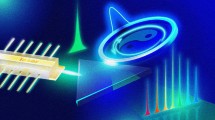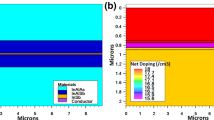Abstract
A theoretical model is developed for n–p–n mid-infrared transistor lasers (TLs) with a strain-balanced Ge0.85Sn0.15 multiple quantum well (MQW) structure in their base. The variation of the optical confinement factor, the modal gain, and the threshold current density is rigorously investigated for different numbers (N) of QWs in the MQW structure. The results show that overall the optical confinement factor and the modal gain increase with N. The frequency response of the MQWTL in the common-base (CB) configuration is estimated from the small-signal relationship between the photon density and the emitter current density by solving the laser rate equation and the continuity equation, considering the virtual states as a conversion mechanism. Increasing N causes the modulation bandwidth first to increase then to decrease with N. This reveals a shift in the nature of the device for higher values of N. The results also suggest that judicious selection of N will enable the proposed device to become a viable monolithic light source.








Similar content being viewed by others
Availability of data and materials
It is confirmed that all data and materials as well as software applications or custom code support their published claims.
References
Soref, R.: Mid-infrared photonics in silicon and germanium. Nat. Photon. 4, 495 (2010)
Lo, G.Q., et al.: Silicon photonics technologies for monolithic electronic-photonic integrated circuit. ECS Trans. 28, 3–11 (2010)
Nagase, R.: Fiber-optic interconnect technologies. Proc. SPIE 11286, Optical Interconnects XX, 112860E (2020)
Dardano, P., Ferrara, M.: Integrated photodetectors based on group IV and colloidal semiconductors: current state of affairs. Micromachines 11, 1–24 (2020)
Pareek, P., Das, M.K., Kumar, S.: Responsivity calculation of group IV-based interband MQWIP. J. Comput. Electron. 17, 319–328 (2018)
Liang, D., Bowers, J.E.: Recent progress in lasers on silicon. Nat. Photon. 4(8), 511–517 (2010)
Rong, H., Xu, S., Cohen, O., Raday, O., Lee, M., Sih, V., Paniccia, M.: A cascaded silicon Raman laser. Nat. Photon. 2(3), 170–174 (2008)
Camacho-Aguilera, R.E., Cai, Y., Patel, N., Bessette, J.T., Romagnoli, M., Kimerling, L.C., Michel, J.: An electrically pumped germanium laser. Opt. Express. 20(10), 11316–11320 (2012)
Soref, R., Buca, D., Yu, S.Q.: Group IV photonics: driving integrated optoelectronics. Opt. Photon. News 27(1), 32–39 (2016)
Soref, R.: Emerging SiGeSn integrated-photonics technology. IEEE Photonics Society Summer Topical Meeting Series (SUM), CA, pp. 100–101 (2016)
Kouvetakis, J., Menedez, J., Chizmeshya, A.V.G.: Tin based group IV semiconductors: new platforms for opto and micro electronics and silicon. Annu. Rev. Mater. Res. 36, 497–554 (2006)
Walter, G., Holonyak, N., Jr., Feng, M., Chan, R.: Laser operation of a heterojunction bipolar light-emitting transistor. Appl. Phys. Lett. 85, 4768–4770 (2004)
Zhang, L., Leburton, J.: Modeling of the transient characteristics of heterojunction bipolar transistor lasers. IEEE J. Quantum Electron. 45(4), 359–366 (2009). https://doi.org/10.1109/JQE.2009.2013215
Taghavi, I., Kaatuzian, H., Leburton, J.P.: Bandwidth enhancement and optical performances of multiple quantum well transistor lasers. Appl. Phys. Lett. 100, 231114 (2012)
Taghavi, I., Kaatuzian, H., Leburton, J.: Performance optimization of multiple quantum well transistor laser. IEEE J. Quantum Electron. 49(4), 426–435 (2013). https://doi.org/10.1109/JQE.2013.2250488
Li, Y., Leburton, J.P.: Base transport factor and frequency response of transistor lasers. J. Appl. Phys. 126, 153103 (2019)
Ranjan, R., Das, M.K.: Theoretical estimation of optical gain in Tin incorporated group IV alloy based transistor laser. Opt Quantum Electronics. 48, Article no. 201 (2016)
Ranjan, R., Das, M.K., Kumar, S.: Performance analysis of tin-incorporated group-IV alloy based transistor laser. Opt. Laser Technol. 106, 228–233 (2018)
Ranjan, R., Pareek, P., Askari, S.S.A., Das, M.K.: Performance Analysis of GeSn Alloy Based Multiple QuantumWell Transistor Laser. Proc. SPIE 10526, Physics and Simulation of Optoelectronic Devices XXVI, 105262A (2018)
Mukhopadhyay, B., Sen, G., De, S., Basu, R., Chakraborty, V., Basu, P.K.: Calculated characteristics of a transistor laser using alloys of Gr-IV elements. Phys. Status Solidi B 255, 1800117 (2018)
Basu, R., Kaur, J., Sharma, A.K.: Analysis of a direct-Bandgap GeSn-based MQW transistor laser for mid-infrared applications. J. Electron. Mater. 48, 6335–6346 (2019)
Basu, R., Mukhopadhyay, B., Basu, P.K.: Analytical model for threshold base current of a transistor laser with multiple quantum wells in the base. IET Optoelectron. 7(3), 71–73 (2013)
Basu, R., Mukhopadhyay, B., Basu, P.K.: Modeling resonance-free modulation response in transistor lasers with single and multiple quantum wells in the base. IEEE Photonics J. 4(5), 1572–1581 (2012)
Faraji, B., Shi, W., Pulfrey, D.L., Chrostowski, L.: Analytical modeling of the Transistor Laser. IEEE J. Sel. Top. Quantum Electron 15(3), 594–603 (2009)
Ranjan, R., Pareek, P., Askari, S.S.A., Das, M.K.: Small signal analysis of tin-incorporated group-IV alloys based multiple quantum well Transistor Laser. In International Conference on Numerical Simulation of Optoelectronic Devices (NUSOD), Hong Kong, pp. 73–74 (2018)
Chang, G.E., Chang, S.W., Chuang, S.L.: Strain-balanced GezSn1–zSixGeySn1–x–y multiple-quantum-well lasers. IEEE J. Quantum Electron. 46, 1813–1820 (2010)
Van de Walle, C.G.: Band lineups and deformation potentials in the model-solid theory. Phys. Rev. B 39(3), 1871–1883 (1989)
Kroemer, H., Okamoto, H.: Some design considerations for multi-quantum-well lasers. Jpn. J. Appl. Phys. 23(8), 970–974 (1984). https://doi.org/10.1143/JJAP.23.970
Nagarajan, R., Ishikawa, M., Fukushima, T., Geels, R.S., Bowers, J.E.: High speed quantum-well lasers and carrier transport effects. IEEE J. Quantum Electron. 28(10), 1990–2008 (1992). https://doi.org/10.1109/3.159508
Acknowledgements
This work is partly supported by a project under CRS (application ID: 1-5748741991), by NPIU a unit of MHRD, Govt. of India at Darbhanga College of Engineering, Darbhanga, Bihar, India
Author information
Authors and Affiliations
Corresponding author
Additional information
Publisher’s Note
Springer Nature remains neutral with regard to jurisdictional claims in published maps and institutional affiliations.
Rights and permissions
About this article
Cite this article
Ranjan, R., Pareek, P., Das, M.K. et al. Numerical design and frequency response of MQW transistor lasers based entirely on group IV alloys. J Comput Electron 20, 1760–1768 (2021). https://doi.org/10.1007/s10825-021-01732-5
Received:
Accepted:
Published:
Issue Date:
DOI: https://doi.org/10.1007/s10825-021-01732-5




